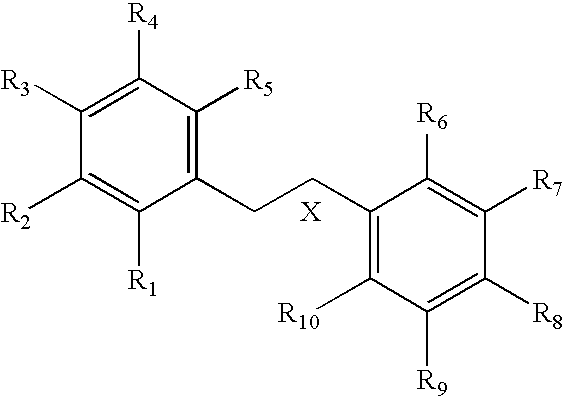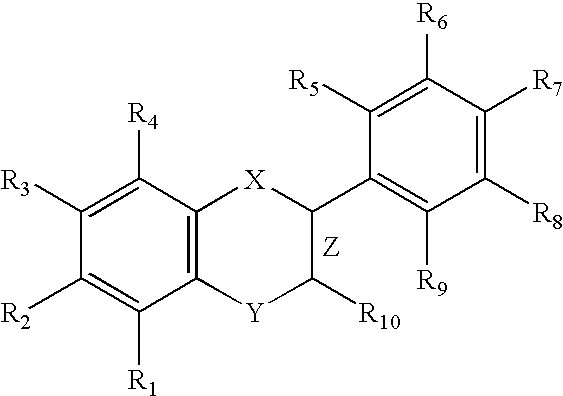Nitric oxide donating derivatives for the treatment of cardiovascular disorders
a technology of nitric oxide and donating derivatives, which is applied in the direction of sugar derivatives, biocide, plant growth regulators, etc., can solve the problems of serious side effects such as flushing, gastrointestinal side effects, and use of fibrates, so as to reduce bioavailability and increase the extent and pathological severity of other factors
- Summary
- Abstract
- Description
- Claims
- Application Information
AI Technical Summary
Benefits of technology
Problems solved by technology
Method used
Image
Examples
example 1
Preparation of 1,3-BIS-nitrooxy-5-[2-(4-nitrooxy-phenyl)-vinyl)-benzene
To a solution of 1 mmol of 5-[(E)-2-(4-hydroxy-phenyl)-vinyl]-benzene-1,3-diol (synonym: resveratrol; 3,4′,5 trihydroxy trans stilbene) in 5 ml of dry THF at 25° C. is added 3 mmol of SOCl(NO.sub.3) or SO(NO.sub.3).sub.2. After 1 hr, Et.sub.2O (diethyl ether) is added and the solution is washed with water, dried and evaporated. The fully nitrated product (1,3-BIS-nitrooxy-5-[(E)-2-(4-nitrooxy-phenyl)-vinyl)-benzene) and the partially nitrated products (wherein any of the hydroxyl groups are independently replaced by ONO.sub.2 groups) are purified and isolated by chromatography on silica gel.
example 2
Preparation of Piceatannol Tetranitrate
To a solution of 1 mmol of 1,2-benzenediol, 4-(2-(3,5-dihydroxyphenyl)ethenyl)-(E)-(synonym: piceatannol) in 5 ml of dry THF at 25° C. is added 4 mmol of SOCl(NO.SUB.3) or SO(NO.SUB.3).sub.2. After 1 hr, Et.sub.2O (diethyl ether) is added and the solution is washed with water, dried and evaporated. The fully nitrated product (piceatannol tetranitrate) and the partially nitrated products (wherein any of the hydroxyl groups are independently replaced by ONO.sub.2 groups) are purified and isolated by chromatography on silica gel.
example 3
Preparation of Butein Tetranitrate
To a solution of 1 mmol of 3, 4, 2′, 4′-tetrahydroxychalcone (synonym: butein) in 5 ml of dry THF at 25° C. is added 4 mmol of SOCl(NO.SUB.3) or SO(NO.SUB.3).sub.2. After 1 hr, Et.sub.2O (diethyl ether) is added and the solution is washed with water, dried and evaporated. The fully nitrated product butein tetranitrate and the partially nitrated products (wherein any of the hydroxyl groups are independently replaced by ONO.sub.2 groups) are purified and isolated by chromatography on silica gel.
PUM
| Property | Measurement | Unit |
|---|---|---|
| structure | aaaaa | aaaaa |
| pharmaceutical composition | aaaaa | aaaaa |
| oxidative vascular stress | aaaaa | aaaaa |
Abstract
Description
Claims
Application Information
 Login to View More
Login to View More - R&D
- Intellectual Property
- Life Sciences
- Materials
- Tech Scout
- Unparalleled Data Quality
- Higher Quality Content
- 60% Fewer Hallucinations
Browse by: Latest US Patents, China's latest patents, Technical Efficacy Thesaurus, Application Domain, Technology Topic, Popular Technical Reports.
© 2025 PatSnap. All rights reserved.Legal|Privacy policy|Modern Slavery Act Transparency Statement|Sitemap|About US| Contact US: help@patsnap.com



